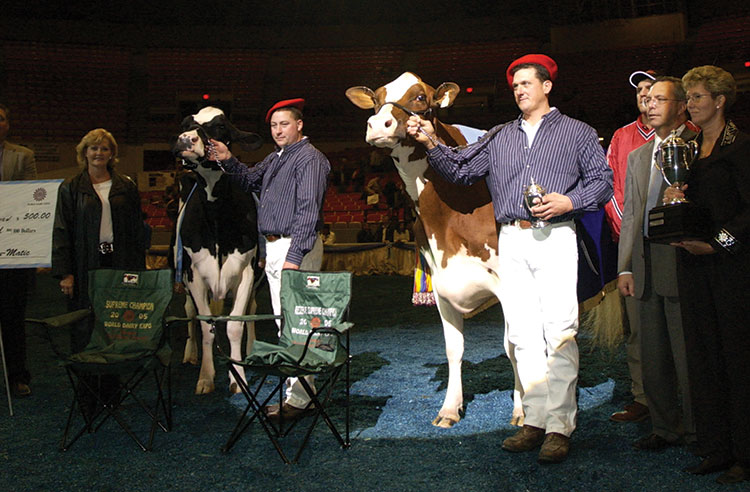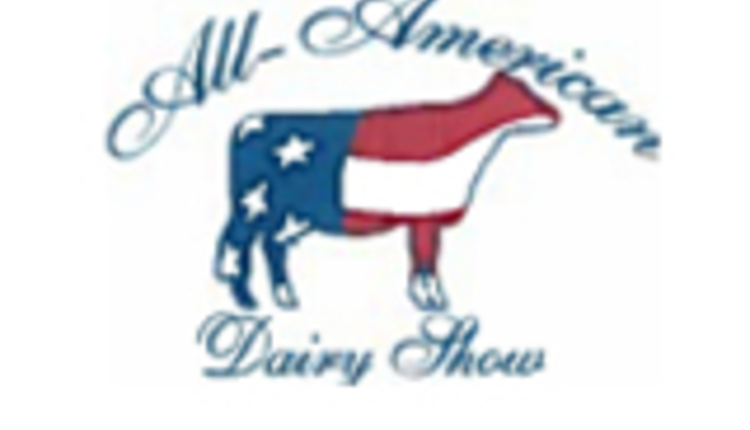The author is an associate editor for Hoard’s Dairyman.

The great ones can go by one name. This is true whether you’re talking about great people or, in dairy’s case, great cows. Among Holstein enthusiasts, there are many “great ones,” cows that are revered as or could be argued to be a one-namer. No matter who you talk to, two names surely to be on that elite list are Blackrose and Paradise.
Stookey Elm Park Blackrose (EX-96 3E) and VanDyk-K Integrity Paradise (EX-96 2E) are just two pieces, though, of the expansive legacy Mark Rueth of Rosedale Genetics — another instantly recognizable name — has built. He is the only person to have owned four different Supreme or Reserve Supreme Champions at World Dairy Expo, and he became just the second person to be awarded both the Duncan MacKenzie and Klussendorf awards. Along with his wife, Nicky, he has developed Rosedale cow families that have made their mark on many corners of the breed.
Those types of achievements don’t come by luck; they result from passion, a strong work ethic, and friends and connections along the way. Those are qualities Rueth has exhibited since his first year showing a grade heifer from his parents’ southeastern Wisconsin farm.
Carving his path
“I’m kind of a result of the Holstein industry,” Rueth described. After that initial year in 4-H, his dad helped him get his first registered calf thanks to a program supported by farms in the county. The heifer turned out to be a good pick that did well at the county fair, and he was hooked. Before long, Rueth was learning to clip his own animals, and then he helped prepare project animals for other 4-H members at the county, and eventually, state fair. Working with and showing against talented peers from around Wisconsin taught him so much, he recalled.
When it came time to think about college, Rueth wanted to follow the friends he had made clipping at local and state shows to the University of Wisconsin-Madison. However, that wasn’t quite how things worked out.
“Maybe the best thing that ever happened to me was I didn’t get accepted there,” he said.
Instead, he landed at the University of Wisconsin-River Falls, where among the new dairy people he met was Todd Doornink. “He was working sales for Tom Morris, and I thought, ‘Oh that’s the coolest thing, you get to travel around clipping,’” Rueth remembered. “I looked up to Todd and what he was doing quite a bit.”
Rueth kept his clippers sharp by occasionally working with the River Falls Dairy Club for farms in the area, but a big opportunity came along when the National Holstein Convention was held in Milwaukee in 1986. Helping Doornink at the convention’s sale began to open more doors for Rueth, and the next year, he interned with Morris, a pioneering and renowned dairy sale manager. “I would go in prior to the sale crew and help at the farm to do some clipping and get things organized for these sales,” Rueth explained.
Two sales he worked turned into long-lasting jobs and relationships that changed his career. In Wisconsin, Rueth went to Bob and Karyn Schauf’s Indianhead Holsteins to clip prior to a sale when Schauf was also preparing for district show. He allowed Rueth to come along, and after a successful district show and then state show, “Bob goes, ‘I want to hire you for all of the shows,’” Rueth chuckled.
A trip to Washington for a Skagvale Holsteins sale led him to meet Sherm Polander, who quickly recognized Rueth’s talents and invited him to work the next show with him, even taking the care to fly him out from Wisconsin. “I would fly out six or seven times a year from college to work state shows, spring shows, Western National, classification, and other things out there,” Rueth said of that continued relationship. He ended up working for both Schauf and Polander for a dozen years.
He picked up more West Coast work at sales and shows in Idaho and up into British Columbia that helped him develop his craft and meet more people around the country. Over time, Rueth worked with the likes of Elmvue, Pamtom, and Continental Holsteins, improving his skills and finding new opportunities. “Those were the ways you find to grow your talents,” he said. “If you work hard and do a good job, there’s always plenty of work.”
Rueth spent a lot of time in airports in those days. On one of his trips through the Seattle airport, he remembers picking up a book with a title advising readers they could become a millionaire with a positive attitude. He was clearly already motivated to work, but reading that book encouraged him to set goals for his future. They included having an All-American nomination and a cow that won at World Dairy Expo.
A goal and then some
Working so much on the West Coast had exposed Rueth to a number of great cows, including a Guernsey named Westlynn Tom Dee, who had done well at a number of shows. “She was a really neat individual, my type of cow,” Rueth said. He had worked with Clark and Joy Vilter of Wisconsin, so he knew a bit about Guernsey genetics and bought her with Randy Kortus. They later added the Vilters into the partnership. “My dad always told me, ‘If you buy an animal, you should pay a little more money and buy something good,’” Rueth shared. “That was always in the back of my mind.”
Tom Dee was a good one, so good that she eventually scored EX-96 and was Grand Champion of the International Guernsey Show four straight years from 1993 to 1996. In 1995, she was also Reserve Supreme Champion, marking Rueth’s first, but not last, honor during Expo’s Supreme ceremony.
Rueth’s time in Washington had also introduced him to Kent and Trisha Van Dyk of VanDyk-K. That relationship led to him purchasing a calf by the name of Paradise, who would go on to be Rueth’s first Holstein Supreme Champion when she won in both 2000 and 2002. The Van Dyks remained partners in her, and Rueth appreciates all of the people he’s owned cattle with over the years. “Partnerships can be difficult, but they bring a lot of enjoyment and fun,” he said.
A partnership and purchase closer to home gave Rueth the cow that would change his herd the most. Remember Bob Schauf? He and Mark van Mersbergen from Washington became Rueth’s partners in purchasing Stookey Elm Park Blackrose at a sale in 1991.
Rueth and his good friend Joel Kietzman, who became the third person to win both the MacKenzie and Klussendorf Awards, had worked at the Elm Park farm quite a bit and had even clipped Blackrose’s dam. He remembers they took Blackrose to Expo as a yearling, where she finished “middle of the pack, but she was a big heifer with a nice square rump.” When Rueth later was working the Elm Park sale she was in, he called van Mersbergen about purchasing a different animal, and when his friend asked what else was in the sale, Rueth mentioned Blackrose. Van Mersbergen was interested, and he remained in even after Rueth ended up paying a little more for the bred heifer than he had intended.
At that point, the cattle Rueth owned were scattered around at the farms he worked with, so he arranged with the Schaufs to house her and added them as partners when Blackrose won their district show as a 2-year-old. As they say, the rest is history.
“It’s been like a godsend she came around and developed well, and we kept breeding off it,” Rueth said of the “Rose” behind Rosedale Genetics. Descendants of Blackrose and her daughter, Rosedale Lea-Ann, have influenced the breed for years via Rueth’s own breeding and other producers throughout the country. In 2017, Rosedale hosted a large sale at their farm in Oxford, Wis., to downsize the herd, and they have done multiple tag sales.
Genetics from the Blackrose and Paradise families are a staple in these events, and having worked so many sales throughout his career, Rueth knows what it takes to put on a good one. “I say it’s like going to a concert for a great artist. They come because they like what you have done,” he described.
Of course, Blackrose also contributed to Rueth’s Expo Supreme record. In 2005, her great-granddaughter Lavender Ruby Redrose-Red became the first (and so far, only) Red and White to be named Supreme Champion. “That was quite historical, quite exciting,” Rueth shared.
The following year, Rueth himself made history when his cow Kinyon Linjet Ideal, co-owned with Marty Kinyon, was named Reserve Supreme Champion at Expo, marking four Supreme and Reserve nods.
Sharing his skills
An astute cow man, Rueth said he always knew in the back of his mind he wanted to farm. In 2001, he was able to bring together all of his animals together in one place at a farm he and Nicky rented. After building up animals and experience for a few years, they purchased the farm in Oxford where they currently milk. You might even see Rueth’s name come up on some winners at Expo’s World Forage Analysis Superbowl, too, as forage genetics are equally important as cattle genetics to him.
He’s also turned his showring expertise into a judging career that’s taken him to shows around the world, including the International Holstein Show in 2009. It’s a job he takes seriously to make the show a good experience for everyone. “I always say it’s about the cows in the ring, but when a judge does a good job, he can enhance a show — make it exciting to watch and recognize the really good cows,” Rueth believes.
He’s seen the changes in the Holstein breed from both of those angles and has used that knowledge to make shows better. Rueth served on Expo’s Dairy Cattle Show Committee and he was instrumental in advocating for raising the Holstein production class standard from 125,000 pounds to 150,000 pounds. He also was a driving voice behind introducing a summer Junior Two-Year-Old class, which multiple breeds have adopted.
Being recognized by his peers for his skills with dairy cattle with both the Duncan MacKenzie Award, in 1995, and the Klussendorf Award, in 2008, he was honored to join such special groups of people. “You may not always see them in the showring, but they spend so many hours of the day by the cow’s side,” he said. He also currently serves as the president of Klussendorf Association, leading the effort to recognize more deserving people with these awards.
Rueth’s record in the Supreme Champion ceremony at Expo is a remarkable one; it’s anyone’s guess if it will ever be matched. It underscores the efforts of a passionate eye for dairy cattle that was sharpened thanks to years of detailed work around the country. In the bloodlines he’s developed, that work is sure to remain name-worthy for years to come.









